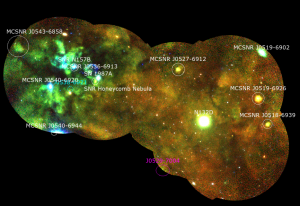Nearly two years after launch, the eROSITA consortium, in which the observatory is heavily involved, will have its first data release. This release, called early data release (EDR), will include the calibration and science verification observations. These observations were carried out between September and December 2019 before eROSITA started its planned all-sky survey. The EDR includes about 100 single observations of multiple sky regions. Many different astrophysical objects have been observed during this phase, covering objects within the Milky Way up to distant galaxy clusters. Those data, which can be used for images, spectra and time-domain analysis, will help scientists around the world to gain a better understanding of the X-ray sky. From now on the data is public and can be used.
The EDR is accompanied by the release of 35 papers, in which these data have been studied by scientists of the eROSITA consortium. Within the consortium, students and professors alike have put great effort into the publications and the EDR itself. About 40% of all EDR publications are led by female scientists. Two of these scientist are from the Remeis observatory, Dr. Sara Saeedi and Prof. Dr. Manami Sasaki.
While most papers deal with the data from the “eROSITA final equatorial depth survey” ( eFEDS), other commissioning and calibration data are analyzed in the papers as well. For its first-light observation eROSITA observed the Large Magellanic cloud (LMC), the closest and largest satellite galaxy of the Milky Way. Its first light image is shown in the picture. The analysis of the LMC EDR data was led by Prof. Manami Sasaki and involved colleagues from the observatory and from around the world. In her publication, the distribution of hot plasma within the LMC was analyzed, which revealed complex structures in the interstellar medium.

Mosaic of the EDR observation of the LMC. On the left side the Tarantula-nebula and several supernova remnants can be seen. The image also shows the diffuse emission in the LMC. © eROSITA collaboration, Sasaki et al.
Five eROSITA calibration observations have targeted the massive globular cluster (GC) 47 Tuc in the Galactic halo. Previous radio/X-ray observations, which were limited to the center of 47 Tuc, confirmed the presence of 23 millisecond pulsar within the half mass radius of this GC. For the first time observations of eROSITA gave the opportunity to intensively study the X-ray sources in 47 Tuc. The study reveals the presence and also the nature of low luminosity X-ray sources, which are mainly different types of accreting white dwarfs, and low mass X-ray binaries in this GC.
Multiple junior and senior scientists from the observatory were involved in the work presented in the 35 papers. The EDR will help scientist to prepare for the upcoming eROSITA all-sky scans and gives an already impressive insight into the capabilities of eROSITA.
Further information:
For more information contact:
Manami Sasaki
Manami.Sasaki@fau.de
+49 9131 85-81019
Sara Saeedi
sara.saeedi@fau.de
+49 9131 85-81012
Jörn Wilms
Joern.Wilms@sternwarte.uni-erlangen.de
+49 9131 85-81013






